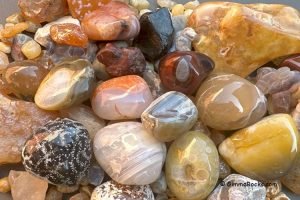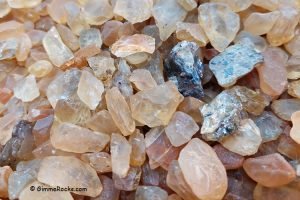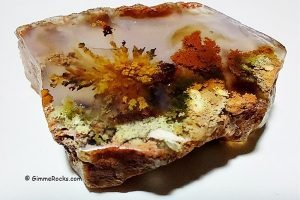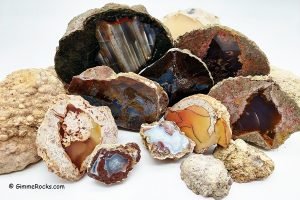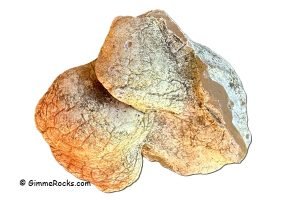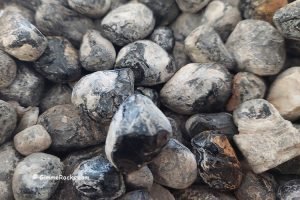Fire Agate is a variety of non-banded chalcedony, treasured for its vivid iridescence and dynamic play of colors. This rare gemstone owes its brilliance to a transparent quartz layer over a thin layer of iron oxide minerals like limonite (or goethite) and hematite.
Its rarity and beauty make this mineral a favorite among rockhounds, lapidary artists, and gemstone collectors. In this guide, we’ll explore the formation of Fire Agate, where you can find it, and tips for processing this unique mineral.
Fire Agate Formation
Fire Agate forms in volcanic rock cavities, with its origins dating back approximately 30 million years to the Tertiary Period. Intense volcanic activity created the ideal conditions for its formation.
Over millions of years, silica-rich waters layered chalcedony and iron oxide, creating the stone’s distinctive fiery iridescence. This process occurs only in specific geological environments and requires the right combination of conditions, such as volcanic activity, mineral-rich water, and extensive time. This is why this type of agate is significantly rare.
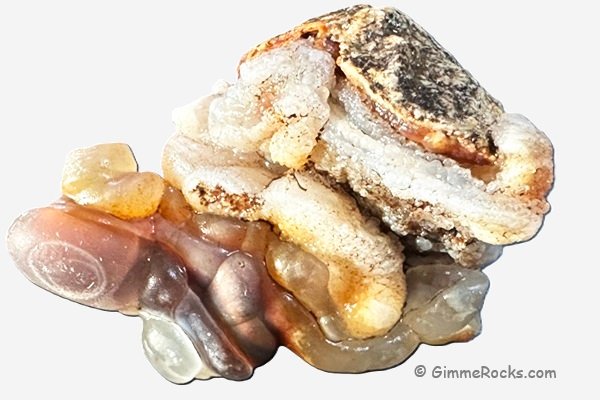
What Makes Fire Agate Sparkle?
The iridescence is primarily caused by the presence of goethite (a hydrous iron oxide), though hematite (an iron oxide) can also play a role in some cases. The iridescent effect is the result of light interference within the thin layers of these iron oxide minerals, which form as inclusions within the chalcedony.
These minerals form layers within the chalcedony during the stone's formation. These layers are typically microscopic and vary in thickness. As light passes through the layers, some wavelengths are reflected back to the eye, while others are absorbed, creating the striking play of colors—typically yellow, orange, red, green, blue, and sometimes purple—seen in high-quality specimens. The key process is similar to soap bubbles, which create a play of colors.
Both goethite (limonite) and hematite contribute to the phenomenon, but the exact contribution depends on the specific stone's mineral composition and the microscopic structure of the layers.
Beyond its famous iridescence, Fire Agate can exhibit fluorescence in part of clear chalcedony under ultraviolet (UV) light. When exposed to UV light, some specimens emit a glowing green hue. This fascinating property is caused by trace elements or impurities, such as iron or other minerals, within the stone's structure.
Fire Agate Occurrences
Fire Agate is primarily found in the southwestern United States and Mexico. Some of the most notable locations are listed below.
The United States of America
Arizona: Regions like Round Mountain, Black Hills, Mulligan Peak at Clifton are famous for producing high-quality specimens.
California: The Palo Verde region and Cahuilla area at Cahuilla Mountains are known for Fire Agate's deposits.
Other Notable Locations
Mexico: The northern and central regions of Mexico, particularly the area around Agua Caliente and north of Mexico City, are another rich deposits.
Distinguishing Between Fire Agate and Fire Opal
Fire Agate and Fire Opal are known for their vibrant flashes of color, but they differ significantly in composition, formation, and appearance.
Fire Agate
- Displays vivid, metallic flashes of red, orange, green, and occasionally blue.
- Colors appear on a typically brown background and are arranged in layered, bubble-like patterns.
- The iridescence is stable and does not change with the viewing angle.
- Harder and more durable, making it less prone to scratching compared to Fire Opal.
Fire Opal
- Exhibits color ranges from whitish-yellow to deep orange or red.
- Flashes or patches of color may shift or disappear depending on the angle of view (opalescence).
- Softer and more susceptible to damage than Fire Agate, requiring careful handling.
Lapidary Uses of Fire Agate
Processing Fire Agate is rewarding but challenging. Its unique layered structure requires precision to reveal the vibrant colors without over-grinding. Lapidary artists typically use diamond tools to carefully expose the stone’s iridescent layers.
Jewelry Applications: Fire Agate is often cut into cabochons and set in custom jewelry, such as rings, pendants, and earrings. Its durability and striking appearance make it a popular choice for unique jewelry.
Tumbling Considerations: Fire Agate can be tumbled, but its layers need extra care. Use softer abrasives and check often to avoid damaging its natural shape.
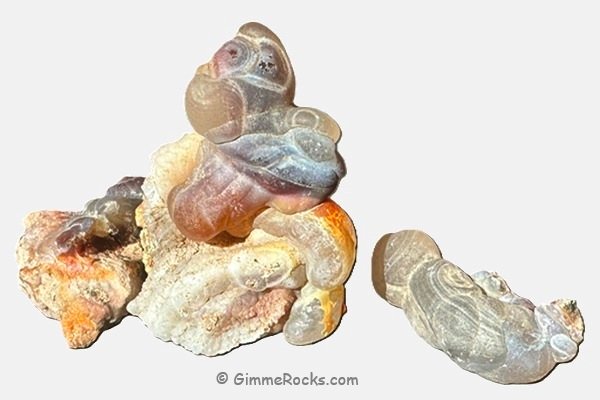
Value of Fire Agate
Fire Agate is a unique gemstone prized for its beauty and rarity. Its value is determined by several factors, including its color, fire intensity, size, shape, craftsmanship, and market demand.
Rough Fire Agate: Typically ranges from $1 to $10 per gram, depending on quality and fire visibility.
Cabochons and Polished Stones: Mid-quality stones range from $10 to $50 per carat, while high-quality specimens can exceed $100 per carat. Exceptional stones with vivid, multi-colored fire can sell for significantly more.
Healing Properties and Benefits of Fire Agate
Fire agate is typically associated with the birth month of March and the zodiac sign Aries (March 21–April 19). It symbolizes passion, strength, and protection.
Known for its fiery colors, fire agate is a stone of creativity, vitality, and motivation. It’s believed to protect, ground, and boost inner strength while inspiring confidence and courage. It may also enhance focus and artistic expression, bringing joy and warmth to its wearer.
You May Also Like
Reference:
Rossman, G.R., "The Optical Properties of Fire Agate," Journal of Gemology, 2015, Vol. 34, pp. 23-34.
Rossman, G. R. (1981). The Cause of Color in Chalcedony and Fire Agate. Contributions to Mineralogy and Petrology.
Wilson, W. E. (1994). Gemstone Phenomena Explained. Gems & Gemology.

